
Endometriosis, which is seen in 10 to 17% of women in the reproductive period and in 50% of women undergoing infertility treatment, occurs when the lining of the uterus forms in any part of the body other than the uterus. Endometriosis, the cause of which is still unknown, is the most important cause of infertility if left untreated. Endometriosis, which manifests itself as severe menstrual pain, pain during sexual intercourse, and inability to conceive despite unprotected intercourse, can be treated with personalized methods by specialist physicians and a multidisciplinary approach. From Memorial Service Hospital, Department of Obstetrics and Gynecology, Op. Dr. Nevin Altuncu Numanoğlu gave information about the causes, symptoms and treatment methods of endometriosis.
If you are unable to conceive despite unprotected intercourse
Endometriosis is a disease that occurs when the tissue lining the uterus settles outside the uterus. Endometriosis most commonly occurs in the ovaries, peritoneum, anterior, posterior, lateral parts of the uterus, intestines, and surgical incisions. Sometimes, it can occur anywhere in the body as a chocolate cyst (endometrioma) in the ovaries, especially at the suture site after cesarean section. Symptoms of endometriosis include lower abdominal pain, painful menstruation, pain during sexual intercourse, and inability to conceive despite unprotected intercourse.
More common in underweight women
10 to 17% of women of reproductive age, 35 to 60% of women with chronic pelvic pain, 10 to 35% of women who have surgery for pelvic pain, and about 50% of women who have surgery for infertility have endometriosis. Endometriosis in girls is rarely seen before menstruation starts and is usually diagnosed when a doctor is consulted because of severe menstrual cramps or breakthrough bleeding. The exact cause of endometriosis is not yet known. However, according to some studies, the groups at risk of endometriosis can be listed as follows:
- Women with a first-degree relative with endometriosis
- Those with structural abnormalities in the uterus
- Women who had their first birth after the age of 30 or who have never given birth
- People who have their first menstrual period at an early age or who enter menopause at a late age
- Women with menstrual cycles of 27 days or less and heavy menstrual bleeding
- Women who are very weak
Do not underestimate the pain during sexual intercourse
The most common symptom of endometriosis is pain. It can also manifest itself with pelvic or lower abdominal pain, pain during menstruation, pain during sexual intercourse, bowel movements and pain during defecation. The symptoms of endometriosis can be constant or cyclical. That is, it worsens before and during menstruation and then improves. Women may have persistent pelvic or lower abdominal pain. Other symptoms include infertility, bowel and bladder symptoms (bloating, constipation, blood in the urine or pain while urinating), and possibly abnormal vaginal bleeding. In some women, endometriosis can be diagnosed incidentally in routine controls without any symptoms.
Endometriosis can be treated with patient-specific methods
It is important that the treatment of endometriosis, which affects 1 out of every 10 women of childbearing age, is carried out with a multidisciplinary study by physicians specialized in this field. The disease, which causes undesirable health problems such as pain, difficulty in conceiving, ovarian cysts, should be followed closely for life with a personalized treatment plan and regular controls. Treatment of endometriosis may vary depending on the extent, level, findings of the disease and whether pregnancy is considered or not. Medication, surgery or a combination of both methods may be used. If there is a pregnancy plan; Treatment is planned by evaluating age and ovarian capacity. The answer to the questions of which treatment will be applied to whom and for how long is shaped according to the patient and the condition of the disease. A patient-specific treatment plan is prepared by evaluating the patient’s age and fertility status. It is aimed not to damage the ovarian reserve in young girls and women who have not given birth. Birth control pills can help the growth of cysts (endometrioma) or endometriosis foci and suppress pain. In addition, patient-specific drugs are also preferred, especially in deep and widespread endometriosis. Surgical treatment is applied to the patient when there is a complaint of pain that is persistent and does not respond to drug treatment, in patients with severe symptoms, whose current life functions are limited, in cases where tissue diagnosis is deemed necessary, and in cases where intestinal or urinary tract obstruction is present.
Source: (BYZHA) – Beyaz News Agency

